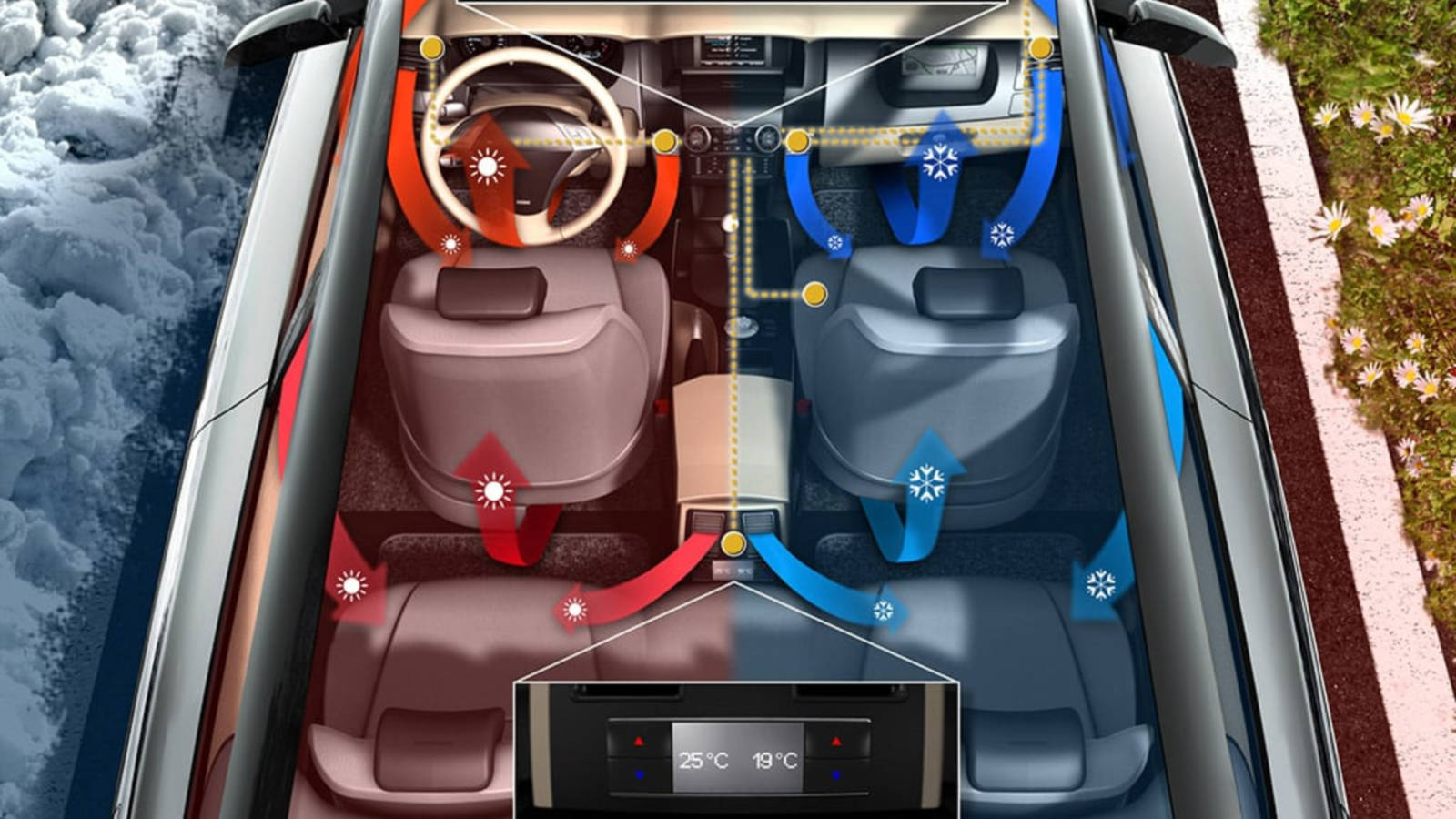A Guide To Automotive Terms: Climate Control

Climate control system is one of the most important features of a car especially in the UAE. Above all features, to tackle the soaring heat and hot temperatures, the air-conditioning system makes the journey comfortable and relaxing.
In this week’s edition of ‘Guide To Automotive Terms’, we will discuss the terminologies involved in climate control or an HVAC (Heating, Ventilation, and Air Conditioning) system.
What Is A Climate Control Or HVAC System?
A Climate Control or HVAC (Heating, Ventilation, and Air Conditioning) system in a car refers to the integrated system designed to regulate and maintain the interior environment of a vehicle. This system is responsible for controlling the temperature, airflow, and air quality within the cabin, ensuring a comfortable and pleasant driving experience for occupants.

The HVAC system plays a crucial role in adapting the vehicle’s interior conditions to meet the preferences of the occupants and to address external weather conditions, making it an integral part of the overall driving experience.
Different Components In An HVAC System?
The HVAC (Heating, Ventilation, and Air Conditioning) system in a vehicle is a complex assembly of various components working together to regulate the interior climate. Here are the key components of an automotive HVAC system:
Compressor
- Function: The compressor pressurizes and circulates the refrigerant (commonly a gas like R134a) through the system.
- Location: Typically located in the engine compartment.
Condenser
- Function: The condenser dissipates heat from the refrigerant, turning it from a high-pressure gas to a high-pressure liquid.
- Location: Positioned in front of the vehicle, often near the radiator.
Evaporator
- Function: The evaporator absorbs heat from the cabin air, causing the refrigerant to evaporate and turn back into a gas.
- Location: Usually located inside the HVAC unit or behind the dashboard.
Expansion Valve/Orifice Tube
- Function: Regulates the flow of refrigerant into the evaporator, controlling its pressure and temperature.
- Location: Positioned between the evaporator and the condenser.
Blower Motor
- Function: Drives the fan that circulates air through the HVAC system.
- Location: Typically located inside the HVAC unit.
Heater Core
- Function: A small radiator that uses hot engine coolant to warm the air before it enters the cabin.
- Location: Often located in the HVAC unit.
HVAC Control Panel/Module

- Function: The interface through which the driver and passengers can control various HVAC settings, including temperature, fan speed, and air distribution.
- Location: Mounted on the dashboard.
Sensors
- Function: Various sensors monitor parameters such as interior and exterior temperatures, humidity levels, and sunlight intensity to adjust the HVAC system accordingly.
- Location: Distributed throughout the vehicle.
Ductwork
- Function: Channels air from the HVAC unit to different parts of the vehicle, ensuring even distribution.
- Location: Runs through the interior of the vehicle.
Cabin Air Filter
- Function: Filters out dust, pollen, and other particles from the outside air before it enters the cabin.
- Location: Positioned in the air intake of the HVAC system.
Blend Door/Actuator
- Function: Controls the mix of hot and cold air entering the cabin, regulating the temperature.
- Location: Inside the HVAC unit.
Recirculation Door/Actuator
- Function: Manages the recirculation of air within the cabin, either from the outside or inside.
- Location: Inside the HVAC unit.
Understanding the components and functions of the vehicle’s HVAC system is crucial for effective diagnosis and maintenance. Routine tasks like replacing filters and checking for leaks contribute to optimal performance and a comfortable driving experience.
How Does A Car Air Conditioning System Work?
A car air conditioning (A/C) system works through a cyclic process driven by the engine.
The compressor pressurizes and circulates refrigerant, which, in the condenser, releases heat and becomes a high-pressure liquid. The expansion valve controls its flow to the evaporator, where it absorbs heat from the cabin air, turning it into a low-pressure gas.

The blower motor propels this cooled air through ducts to various vents, providing a comfortable interior climate. This continuous refrigerant cycle ensures the consistent cooling of the vehicle.
Additional components like the cabin air filter, HVAC control panel, and sensors enhance functionality, contributing to optimal A/C system performance. Regular maintenance is crucial for sustained effectiveness.
Different Types Of Car AC
Manual or Traditional AC: This is the most basic type of car AC system, where the driver manually adjusts the temperature, fan speed, and air distribution.
Automatic Climate Control: Also known as auto AC, this system allows the driver to set a specific temperature, and the system automatically adjusts fan speed, air distribution, and other parameters to maintain that temperature.

Dual-Zone AC: Dual-zone AC allows the driver and front passenger to have different temperature settings, catering to individual comfort preferences.
Multi-Zone AC: Multi-zone AC extends the dual-zone concept to include rear-seat passengers, allowing different temperature settings for various sections of the vehicle.
Difference Between Auto & Manual AC In A Car
Control Mechanism
- Auto AC: Adjusts settings automatically based on a set temperature.
- Manual AC: Requires manual adjustment of temperature, fan speed, and air distribution.
Precision and Automation
- Auto AC: Offers automated and precise climate control.
- Manual AC: Relies on manual input for adjustment.

User Interface
- Auto AC: Typically digital with temperature settings.
- Manual AC: Involves physical knobs and buttons.
Ease of Use
- Auto AC: Considered user-friendly with less manual intervention.
- Manual AC: Provides direct control for active adjustment.
Vehicle Types
- Auto AC: Common in mid to high-end vehicles.
- Manual AC: Often found in entry-level or budget-friendly vehicles.
Other Climate Control Features
Heated & Ventilated Seats

- Heated Seats: Provide warmth to the seat surface, often with adjustable temperature settings.
- Ventilated Seats: Use fans to circulate air through the seat, enhancing comfort in warm weather.
Heated & Ventilated Central Arm-Rest
- Heated Arm-Rest: Similar to heated seats, warms the central armrest for additional comfort.
- Ventilated Arm-Rest: Incorporates airflow to keep the armrest cool during warm conditions.
Heated & Ventilated Steering Wheel
- Heated Steering Wheel: Warms the steering wheel, offering a comfortable grip in cold weather.
- Ventilated Steering Wheel: Allows airflow through the steering wheel for a cooling effect in warm weather.
Cool Box
- A compartment within the car that can cool items placed inside, often used for keeping beverages or snacks cool.
Refrigerator

- Similar to a cool box but typically larger and more sophisticated, it provides refrigerated storage space for perishable items.
Air Purifier
- A system that filters and cleans the air inside the vehicle, removing pollutants, allergens, and particles for improved air quality.
These features enhance the overall comfort and convenience of the vehicle, providing options for temperature control, relaxation, and storage of items in a climate-controlled environment.
Those are all the important terminologies involved in a car’s climate control. We will be explaining other interior sections of a car in the coming weeks in our weekly guide to automotive terms. Keep an eye on the DubiCars Blog section for more such guides.
Looking to own a car? Here is a list of used cars on sale in the UAE and new cars on sale in the UAE.








